ERP Implementation Challenges
VerifiedAdded on 2019/11/19
|17
|4091
|205
Report
AI Summary
The assignment content revolves around the implementation of SAP solution for risk management, corporate governance, and legislation management within a company. The organization aims to align internal processes across business functions and transform into a process-oriented entity. The SAP Access Control 10.0 is implemented to mitigate segregation risks. However, ERP system implementation poses various risks such as ineffective project management, low top management support, and inadequate business process reengineering. To ensure successful implementation, it is crucial to consider critical success factors, align business processes with the ERP system, and manage risks effectively.
Contribute Materials
Your contribution can guide someone’s learning journey. Share your
documents today.
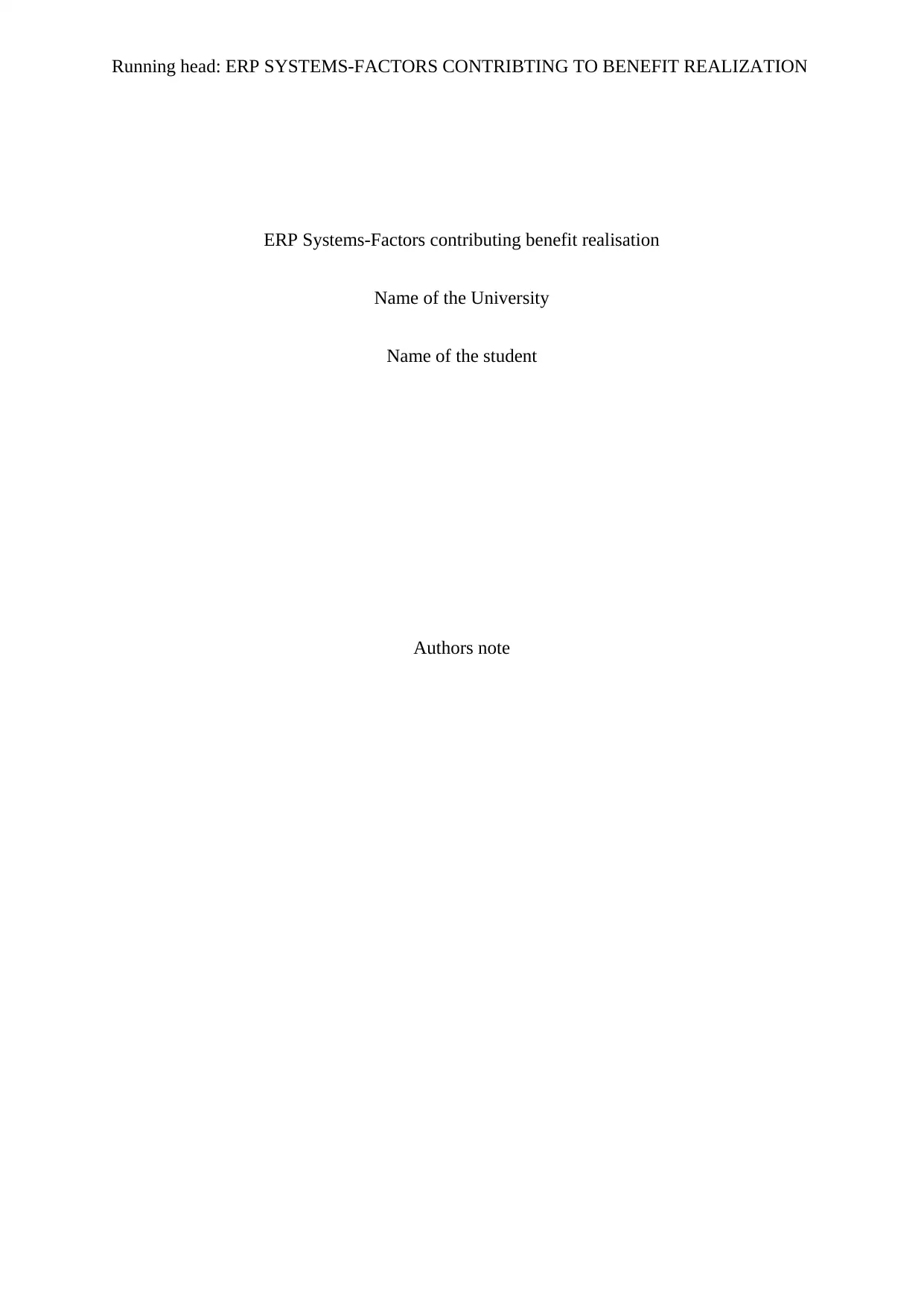
Running head: ERP SYSTEMS-FACTORS CONTRIBTING TO BENEFIT REALIZATION
ERP Systems-Factors contributing benefit realisation
Name of the University
Name of the student
Authors note
ERP Systems-Factors contributing benefit realisation
Name of the University
Name of the student
Authors note
Secure Best Marks with AI Grader
Need help grading? Try our AI Grader for instant feedback on your assignments.
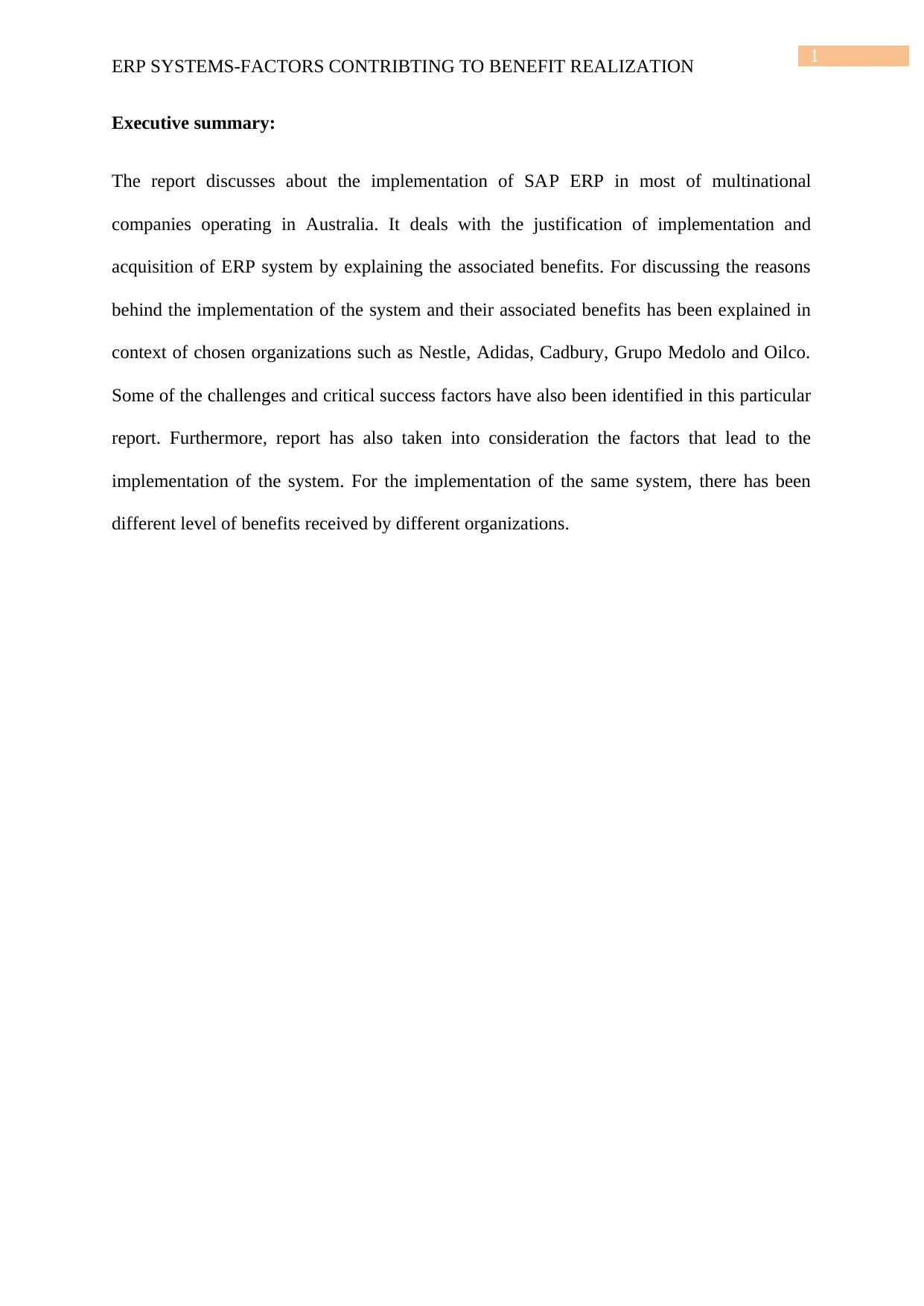
1
ERP SYSTEMS-FACTORS CONTRIBTING TO BENEFIT REALIZATION
Executive summary:
The report discusses about the implementation of SAP ERP in most of multinational
companies operating in Australia. It deals with the justification of implementation and
acquisition of ERP system by explaining the associated benefits. For discussing the reasons
behind the implementation of the system and their associated benefits has been explained in
context of chosen organizations such as Nestle, Adidas, Cadbury, Grupo Medolo and Oilco.
Some of the challenges and critical success factors have also been identified in this particular
report. Furthermore, report has also taken into consideration the factors that lead to the
implementation of the system. For the implementation of the same system, there has been
different level of benefits received by different organizations.
ERP SYSTEMS-FACTORS CONTRIBTING TO BENEFIT REALIZATION
Executive summary:
The report discusses about the implementation of SAP ERP in most of multinational
companies operating in Australia. It deals with the justification of implementation and
acquisition of ERP system by explaining the associated benefits. For discussing the reasons
behind the implementation of the system and their associated benefits has been explained in
context of chosen organizations such as Nestle, Adidas, Cadbury, Grupo Medolo and Oilco.
Some of the challenges and critical success factors have also been identified in this particular
report. Furthermore, report has also taken into consideration the factors that lead to the
implementation of the system. For the implementation of the same system, there has been
different level of benefits received by different organizations.
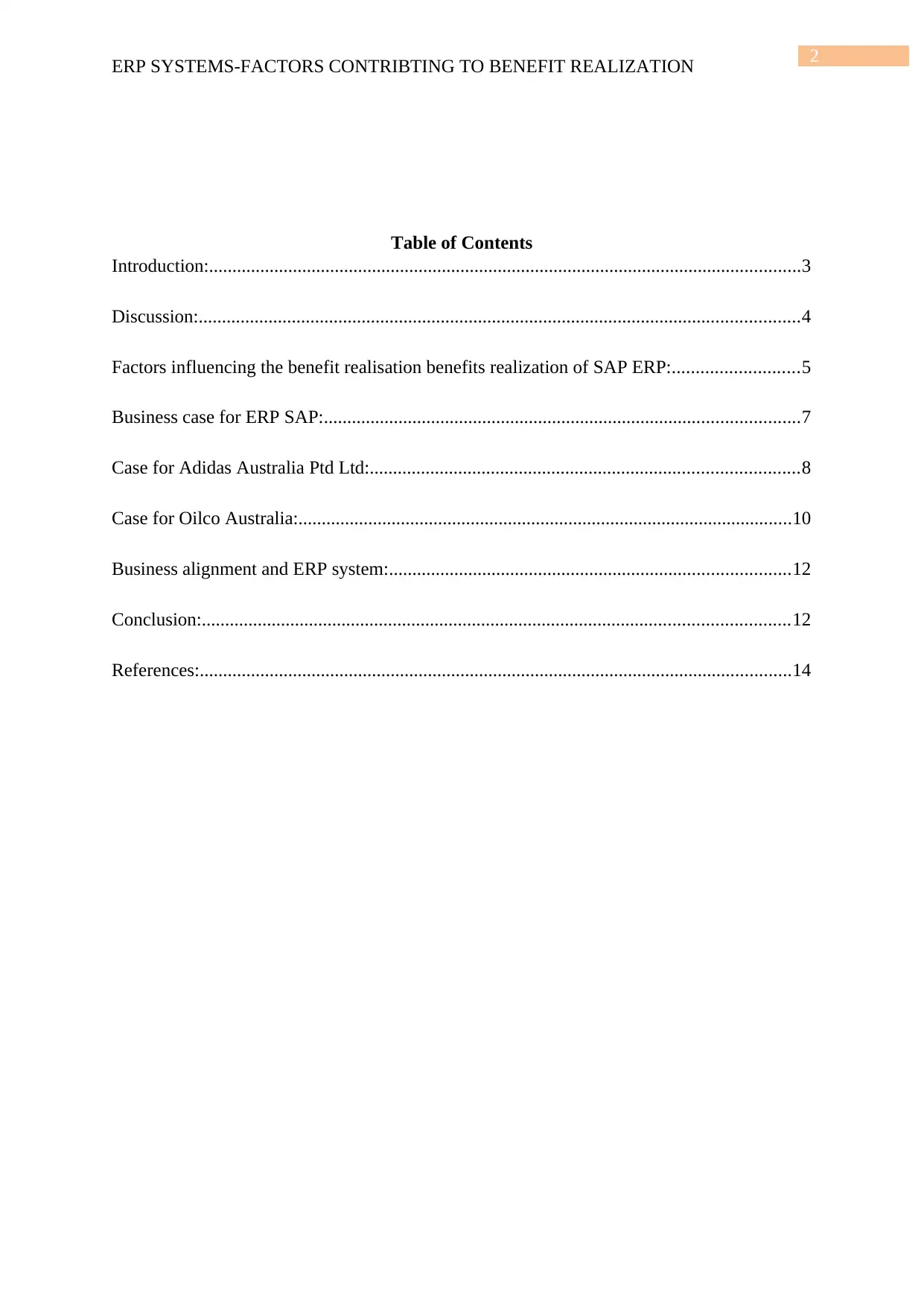
2
ERP SYSTEMS-FACTORS CONTRIBTING TO BENEFIT REALIZATION
Table of Contents
Introduction:...............................................................................................................................3
Discussion:.................................................................................................................................4
Factors influencing the benefit realisation benefits realization of SAP ERP:...........................5
Business case for ERP SAP:......................................................................................................7
Case for Adidas Australia Ptd Ltd:............................................................................................8
Case for Oilco Australia:..........................................................................................................10
Business alignment and ERP system:......................................................................................12
Conclusion:..............................................................................................................................12
References:...............................................................................................................................14
ERP SYSTEMS-FACTORS CONTRIBTING TO BENEFIT REALIZATION
Table of Contents
Introduction:...............................................................................................................................3
Discussion:.................................................................................................................................4
Factors influencing the benefit realisation benefits realization of SAP ERP:...........................5
Business case for ERP SAP:......................................................................................................7
Case for Adidas Australia Ptd Ltd:............................................................................................8
Case for Oilco Australia:..........................................................................................................10
Business alignment and ERP system:......................................................................................12
Conclusion:..............................................................................................................................12
References:...............................................................................................................................14
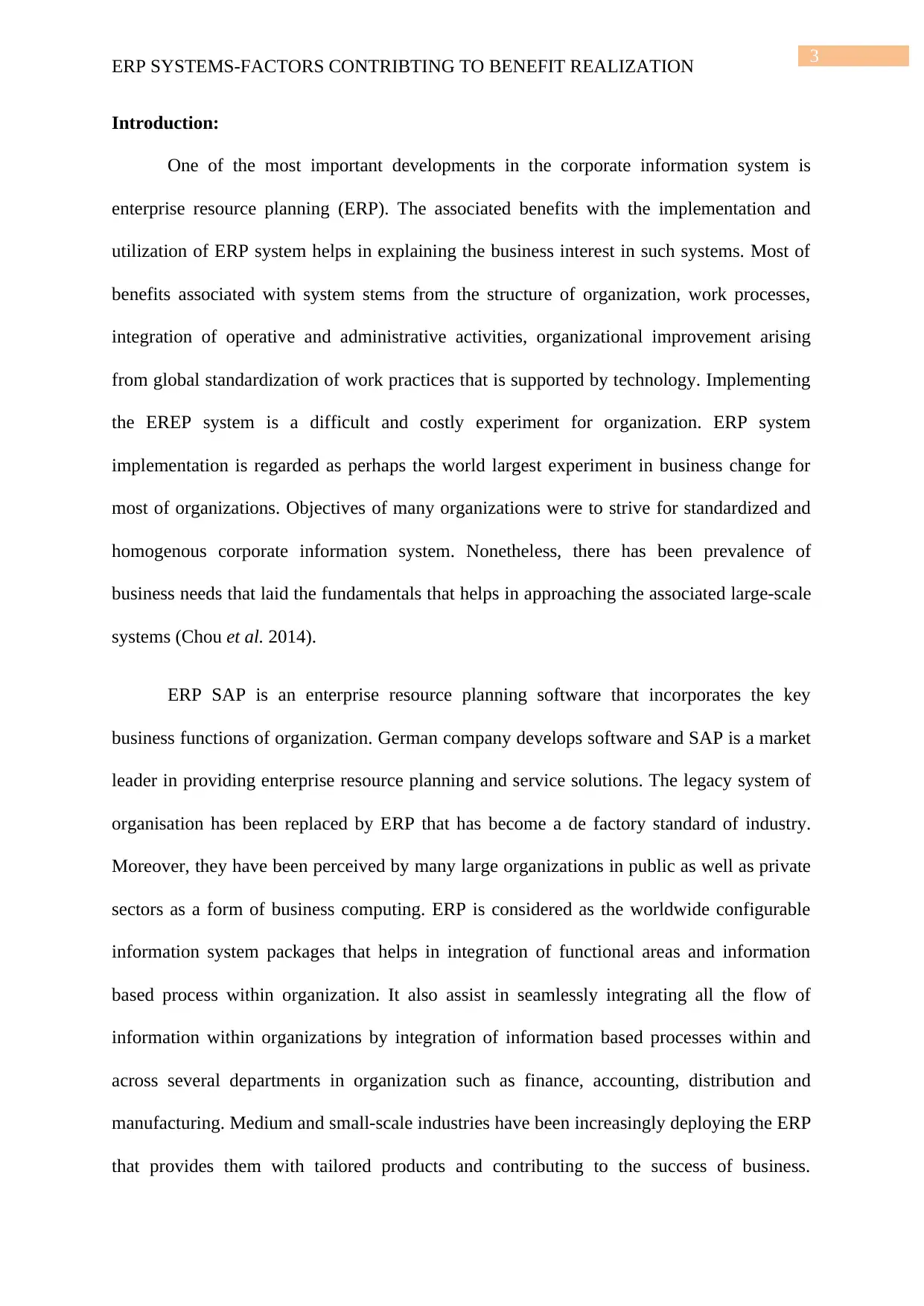
3
ERP SYSTEMS-FACTORS CONTRIBTING TO BENEFIT REALIZATION
Introduction:
One of the most important developments in the corporate information system is
enterprise resource planning (ERP). The associated benefits with the implementation and
utilization of ERP system helps in explaining the business interest in such systems. Most of
benefits associated with system stems from the structure of organization, work processes,
integration of operative and administrative activities, organizational improvement arising
from global standardization of work practices that is supported by technology. Implementing
the EREP system is a difficult and costly experiment for organization. ERP system
implementation is regarded as perhaps the world largest experiment in business change for
most of organizations. Objectives of many organizations were to strive for standardized and
homogenous corporate information system. Nonetheless, there has been prevalence of
business needs that laid the fundamentals that helps in approaching the associated large-scale
systems (Chou et al. 2014).
ERP SAP is an enterprise resource planning software that incorporates the key
business functions of organization. German company develops software and SAP is a market
leader in providing enterprise resource planning and service solutions. The legacy system of
organisation has been replaced by ERP that has become a de factory standard of industry.
Moreover, they have been perceived by many large organizations in public as well as private
sectors as a form of business computing. ERP is considered as the worldwide configurable
information system packages that helps in integration of functional areas and information
based process within organization. It also assist in seamlessly integrating all the flow of
information within organizations by integration of information based processes within and
across several departments in organization such as finance, accounting, distribution and
manufacturing. Medium and small-scale industries have been increasingly deploying the ERP
that provides them with tailored products and contributing to the success of business.
ERP SYSTEMS-FACTORS CONTRIBTING TO BENEFIT REALIZATION
Introduction:
One of the most important developments in the corporate information system is
enterprise resource planning (ERP). The associated benefits with the implementation and
utilization of ERP system helps in explaining the business interest in such systems. Most of
benefits associated with system stems from the structure of organization, work processes,
integration of operative and administrative activities, organizational improvement arising
from global standardization of work practices that is supported by technology. Implementing
the EREP system is a difficult and costly experiment for organization. ERP system
implementation is regarded as perhaps the world largest experiment in business change for
most of organizations. Objectives of many organizations were to strive for standardized and
homogenous corporate information system. Nonetheless, there has been prevalence of
business needs that laid the fundamentals that helps in approaching the associated large-scale
systems (Chou et al. 2014).
ERP SAP is an enterprise resource planning software that incorporates the key
business functions of organization. German company develops software and SAP is a market
leader in providing enterprise resource planning and service solutions. The legacy system of
organisation has been replaced by ERP that has become a de factory standard of industry.
Moreover, they have been perceived by many large organizations in public as well as private
sectors as a form of business computing. ERP is considered as the worldwide configurable
information system packages that helps in integration of functional areas and information
based process within organization. It also assist in seamlessly integrating all the flow of
information within organizations by integration of information based processes within and
across several departments in organization such as finance, accounting, distribution and
manufacturing. Medium and small-scale industries have been increasingly deploying the ERP
that provides them with tailored products and contributing to the success of business.
Secure Best Marks with AI Grader
Need help grading? Try our AI Grader for instant feedback on your assignments.
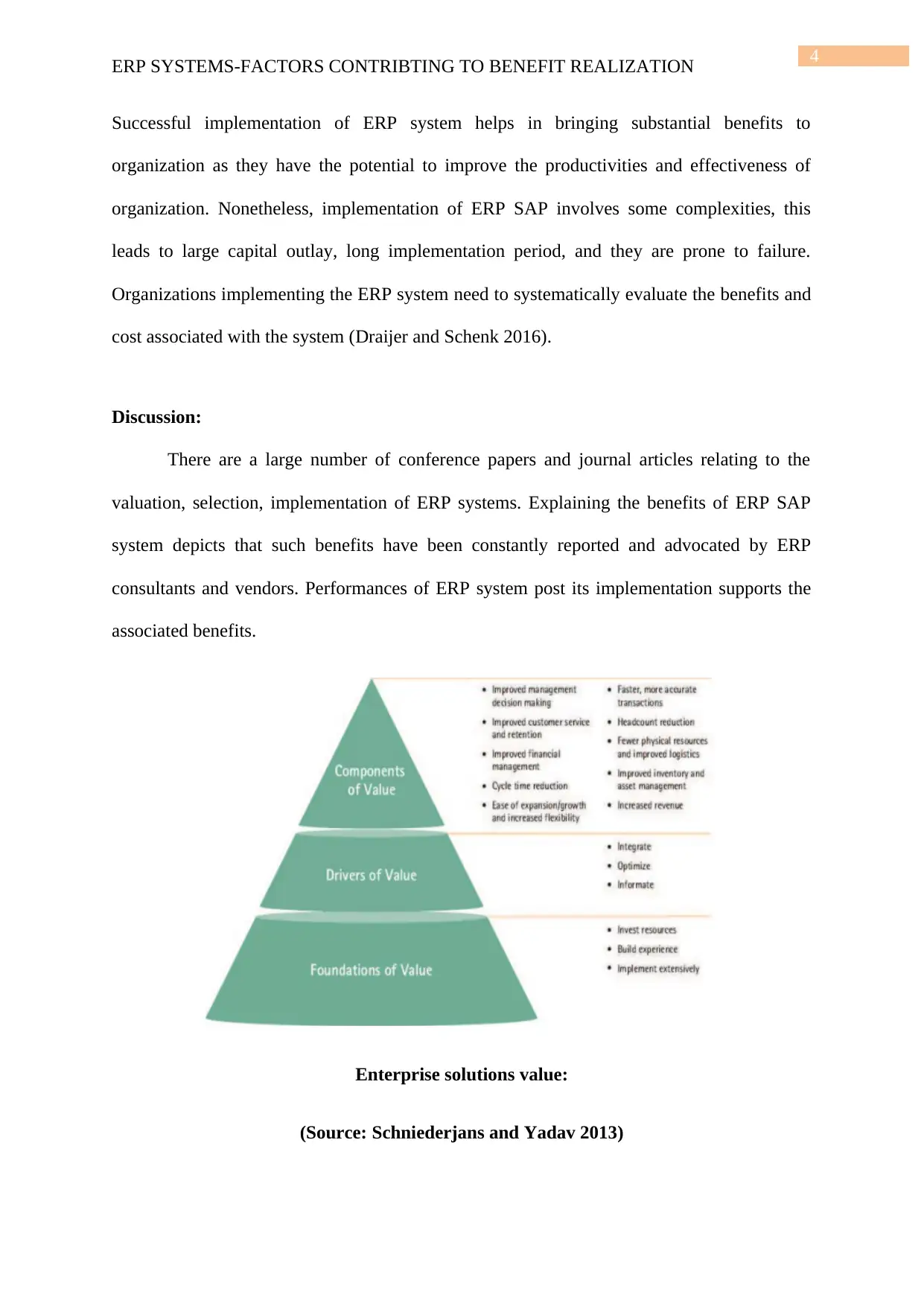
4
ERP SYSTEMS-FACTORS CONTRIBTING TO BENEFIT REALIZATION
Successful implementation of ERP system helps in bringing substantial benefits to
organization as they have the potential to improve the productivities and effectiveness of
organization. Nonetheless, implementation of ERP SAP involves some complexities, this
leads to large capital outlay, long implementation period, and they are prone to failure.
Organizations implementing the ERP system need to systematically evaluate the benefits and
cost associated with the system (Draijer and Schenk 2016).
Discussion:
There are a large number of conference papers and journal articles relating to the
valuation, selection, implementation of ERP systems. Explaining the benefits of ERP SAP
system depicts that such benefits have been constantly reported and advocated by ERP
consultants and vendors. Performances of ERP system post its implementation supports the
associated benefits.
Enterprise solutions value:
(Source: Schniederjans and Yadav 2013)
ERP SYSTEMS-FACTORS CONTRIBTING TO BENEFIT REALIZATION
Successful implementation of ERP system helps in bringing substantial benefits to
organization as they have the potential to improve the productivities and effectiveness of
organization. Nonetheless, implementation of ERP SAP involves some complexities, this
leads to large capital outlay, long implementation period, and they are prone to failure.
Organizations implementing the ERP system need to systematically evaluate the benefits and
cost associated with the system (Draijer and Schenk 2016).
Discussion:
There are a large number of conference papers and journal articles relating to the
valuation, selection, implementation of ERP systems. Explaining the benefits of ERP SAP
system depicts that such benefits have been constantly reported and advocated by ERP
consultants and vendors. Performances of ERP system post its implementation supports the
associated benefits.
Enterprise solutions value:
(Source: Schniederjans and Yadav 2013)
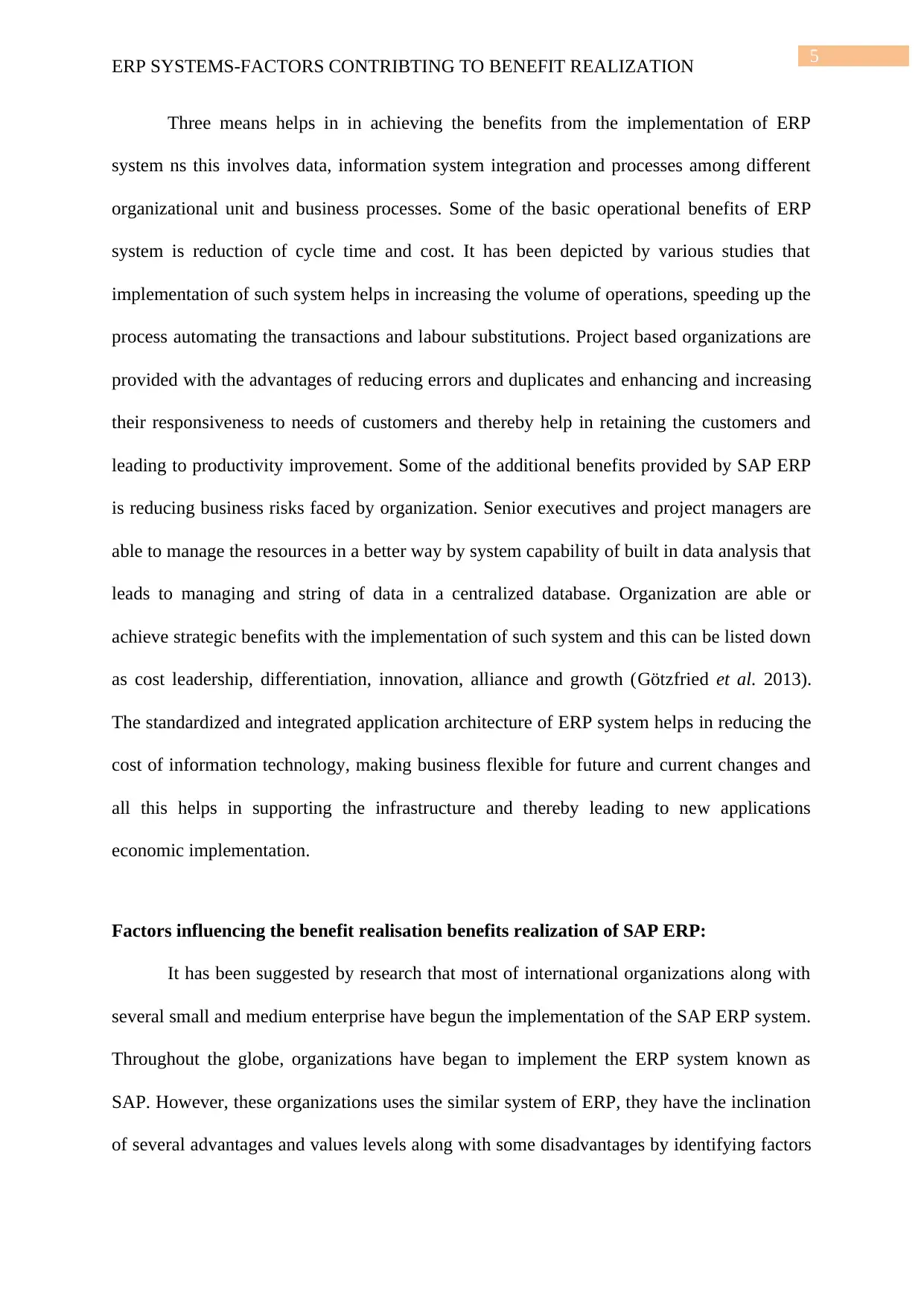
5
ERP SYSTEMS-FACTORS CONTRIBTING TO BENEFIT REALIZATION
Three means helps in in achieving the benefits from the implementation of ERP
system ns this involves data, information system integration and processes among different
organizational unit and business processes. Some of the basic operational benefits of ERP
system is reduction of cycle time and cost. It has been depicted by various studies that
implementation of such system helps in increasing the volume of operations, speeding up the
process automating the transactions and labour substitutions. Project based organizations are
provided with the advantages of reducing errors and duplicates and enhancing and increasing
their responsiveness to needs of customers and thereby help in retaining the customers and
leading to productivity improvement. Some of the additional benefits provided by SAP ERP
is reducing business risks faced by organization. Senior executives and project managers are
able to manage the resources in a better way by system capability of built in data analysis that
leads to managing and string of data in a centralized database. Organization are able or
achieve strategic benefits with the implementation of such system and this can be listed down
as cost leadership, differentiation, innovation, alliance and growth (Götzfried et al. 2013).
The standardized and integrated application architecture of ERP system helps in reducing the
cost of information technology, making business flexible for future and current changes and
all this helps in supporting the infrastructure and thereby leading to new applications
economic implementation.
Factors influencing the benefit realisation benefits realization of SAP ERP:
It has been suggested by research that most of international organizations along with
several small and medium enterprise have begun the implementation of the SAP ERP system.
Throughout the globe, organizations have began to implement the ERP system known as
SAP. However, these organizations uses the similar system of ERP, they have the inclination
of several advantages and values levels along with some disadvantages by identifying factors
ERP SYSTEMS-FACTORS CONTRIBTING TO BENEFIT REALIZATION
Three means helps in in achieving the benefits from the implementation of ERP
system ns this involves data, information system integration and processes among different
organizational unit and business processes. Some of the basic operational benefits of ERP
system is reduction of cycle time and cost. It has been depicted by various studies that
implementation of such system helps in increasing the volume of operations, speeding up the
process automating the transactions and labour substitutions. Project based organizations are
provided with the advantages of reducing errors and duplicates and enhancing and increasing
their responsiveness to needs of customers and thereby help in retaining the customers and
leading to productivity improvement. Some of the additional benefits provided by SAP ERP
is reducing business risks faced by organization. Senior executives and project managers are
able to manage the resources in a better way by system capability of built in data analysis that
leads to managing and string of data in a centralized database. Organization are able or
achieve strategic benefits with the implementation of such system and this can be listed down
as cost leadership, differentiation, innovation, alliance and growth (Götzfried et al. 2013).
The standardized and integrated application architecture of ERP system helps in reducing the
cost of information technology, making business flexible for future and current changes and
all this helps in supporting the infrastructure and thereby leading to new applications
economic implementation.
Factors influencing the benefit realisation benefits realization of SAP ERP:
It has been suggested by research that most of international organizations along with
several small and medium enterprise have begun the implementation of the SAP ERP system.
Throughout the globe, organizations have began to implement the ERP system known as
SAP. However, these organizations uses the similar system of ERP, they have the inclination
of several advantages and values levels along with some disadvantages by identifying factors
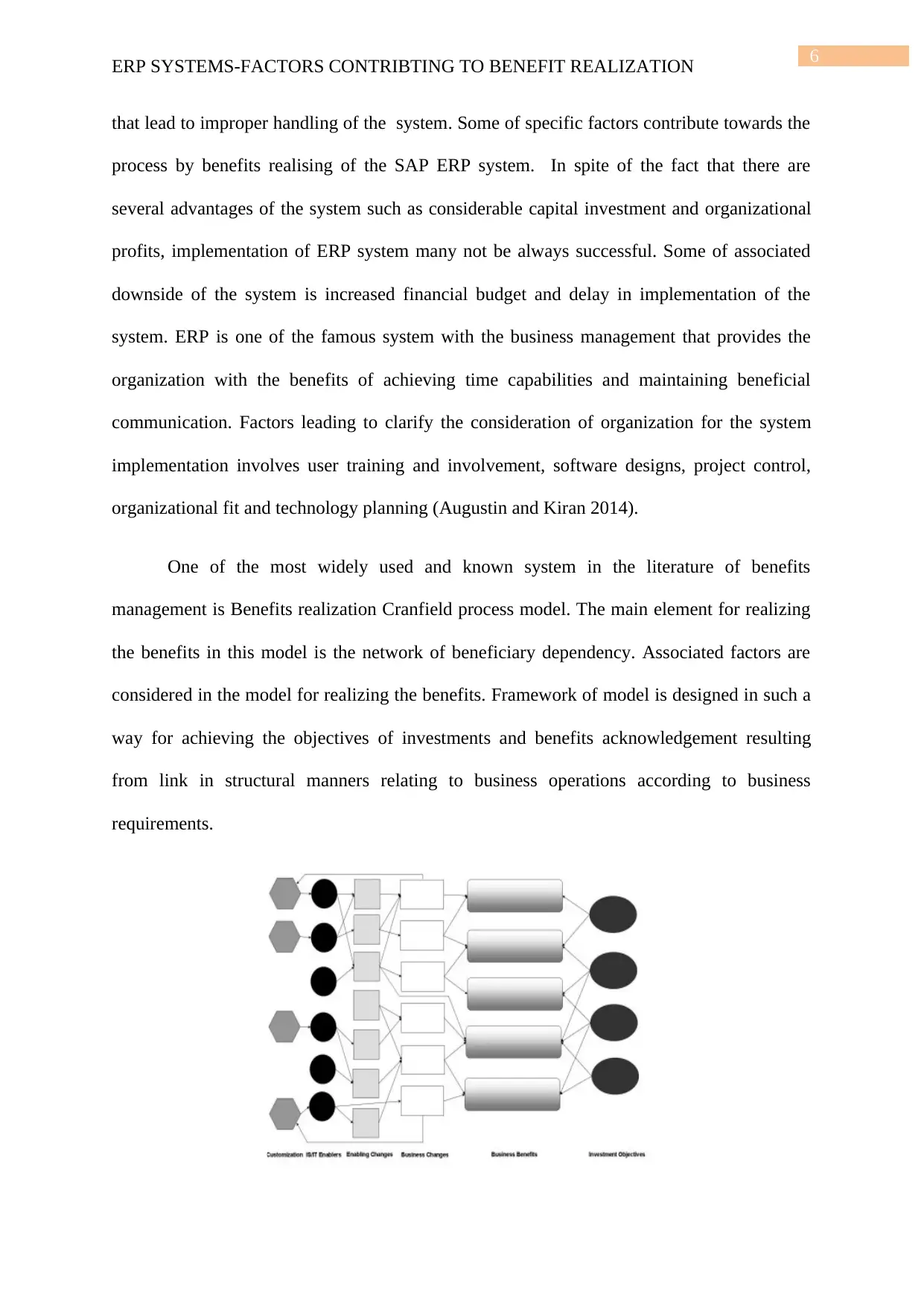
6
ERP SYSTEMS-FACTORS CONTRIBTING TO BENEFIT REALIZATION
that lead to improper handling of the system. Some of specific factors contribute towards the
process by benefits realising of the SAP ERP system. In spite of the fact that there are
several advantages of the system such as considerable capital investment and organizational
profits, implementation of ERP system many not be always successful. Some of associated
downside of the system is increased financial budget and delay in implementation of the
system. ERP is one of the famous system with the business management that provides the
organization with the benefits of achieving time capabilities and maintaining beneficial
communication. Factors leading to clarify the consideration of organization for the system
implementation involves user training and involvement, software designs, project control,
organizational fit and technology planning (Augustin and Kiran 2014).
One of the most widely used and known system in the literature of benefits
management is Benefits realization Cranfield process model. The main element for realizing
the benefits in this model is the network of beneficiary dependency. Associated factors are
considered in the model for realizing the benefits. Framework of model is designed in such a
way for achieving the objectives of investments and benefits acknowledgement resulting
from link in structural manners relating to business operations according to business
requirements.
ERP SYSTEMS-FACTORS CONTRIBTING TO BENEFIT REALIZATION
that lead to improper handling of the system. Some of specific factors contribute towards the
process by benefits realising of the SAP ERP system. In spite of the fact that there are
several advantages of the system such as considerable capital investment and organizational
profits, implementation of ERP system many not be always successful. Some of associated
downside of the system is increased financial budget and delay in implementation of the
system. ERP is one of the famous system with the business management that provides the
organization with the benefits of achieving time capabilities and maintaining beneficial
communication. Factors leading to clarify the consideration of organization for the system
implementation involves user training and involvement, software designs, project control,
organizational fit and technology planning (Augustin and Kiran 2014).
One of the most widely used and known system in the literature of benefits
management is Benefits realization Cranfield process model. The main element for realizing
the benefits in this model is the network of beneficiary dependency. Associated factors are
considered in the model for realizing the benefits. Framework of model is designed in such a
way for achieving the objectives of investments and benefits acknowledgement resulting
from link in structural manners relating to business operations according to business
requirements.
Paraphrase This Document
Need a fresh take? Get an instant paraphrase of this document with our AI Paraphraser
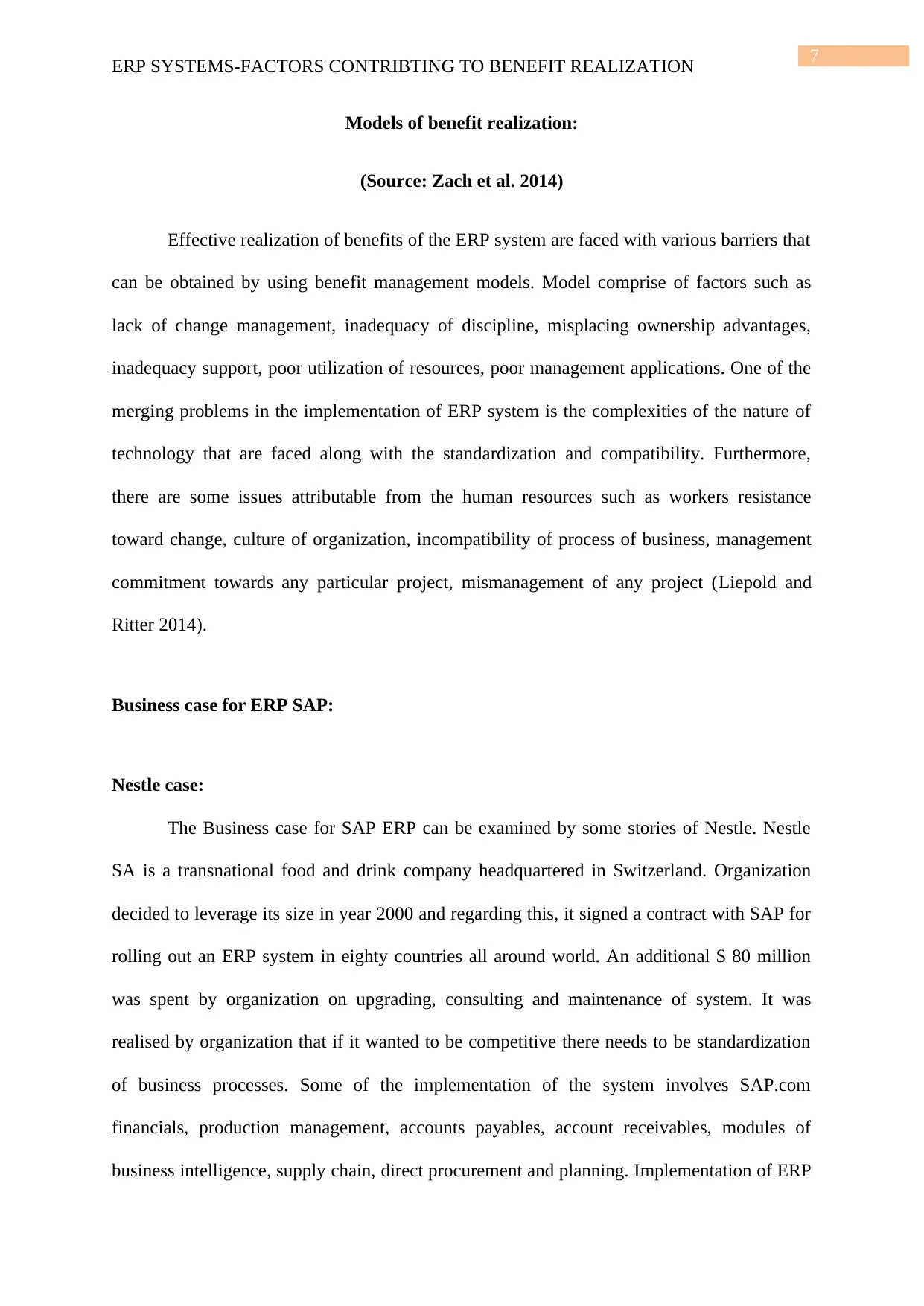
7
ERP SYSTEMS-FACTORS CONTRIBTING TO BENEFIT REALIZATION
Models of benefit realization:
(Source: Zach et al. 2014)
Effective realization of benefits of the ERP system are faced with various barriers that
can be obtained by using benefit management models. Model comprise of factors such as
lack of change management, inadequacy of discipline, misplacing ownership advantages,
inadequacy support, poor utilization of resources, poor management applications. One of the
merging problems in the implementation of ERP system is the complexities of the nature of
technology that are faced along with the standardization and compatibility. Furthermore,
there are some issues attributable from the human resources such as workers resistance
toward change, culture of organization, incompatibility of process of business, management
commitment towards any particular project, mismanagement of any project (Liepold and
Ritter 2014).
Business case for ERP SAP:
Nestle case:
The Business case for SAP ERP can be examined by some stories of Nestle. Nestle
SA is a transnational food and drink company headquartered in Switzerland. Organization
decided to leverage its size in year 2000 and regarding this, it signed a contract with SAP for
rolling out an ERP system in eighty countries all around world. An additional $ 80 million
was spent by organization on upgrading, consulting and maintenance of system. It was
realised by organization that if it wanted to be competitive there needs to be standardization
of business processes. Some of the implementation of the system involves SAP.com
financials, production management, accounts payables, account receivables, modules of
business intelligence, supply chain, direct procurement and planning. Implementation of ERP
ERP SYSTEMS-FACTORS CONTRIBTING TO BENEFIT REALIZATION
Models of benefit realization:
(Source: Zach et al. 2014)
Effective realization of benefits of the ERP system are faced with various barriers that
can be obtained by using benefit management models. Model comprise of factors such as
lack of change management, inadequacy of discipline, misplacing ownership advantages,
inadequacy support, poor utilization of resources, poor management applications. One of the
merging problems in the implementation of ERP system is the complexities of the nature of
technology that are faced along with the standardization and compatibility. Furthermore,
there are some issues attributable from the human resources such as workers resistance
toward change, culture of organization, incompatibility of process of business, management
commitment towards any particular project, mismanagement of any project (Liepold and
Ritter 2014).
Business case for ERP SAP:
Nestle case:
The Business case for SAP ERP can be examined by some stories of Nestle. Nestle
SA is a transnational food and drink company headquartered in Switzerland. Organization
decided to leverage its size in year 2000 and regarding this, it signed a contract with SAP for
rolling out an ERP system in eighty countries all around world. An additional $ 80 million
was spent by organization on upgrading, consulting and maintenance of system. It was
realised by organization that if it wanted to be competitive there needs to be standardization
of business processes. Some of the implementation of the system involves SAP.com
financials, production management, accounts payables, account receivables, modules of
business intelligence, supply chain, direct procurement and planning. Implementation of ERP
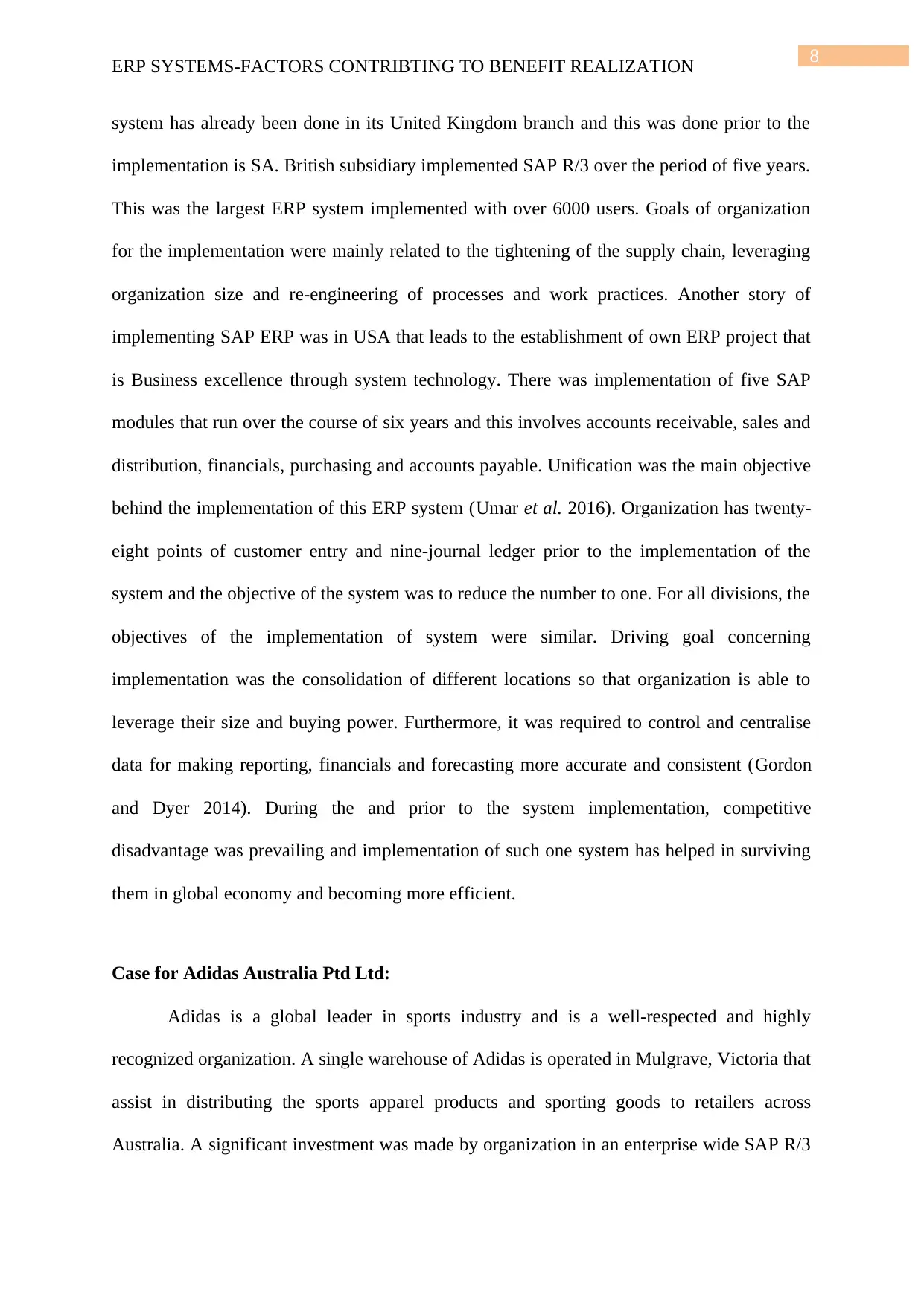
8
ERP SYSTEMS-FACTORS CONTRIBTING TO BENEFIT REALIZATION
system has already been done in its United Kingdom branch and this was done prior to the
implementation is SA. British subsidiary implemented SAP R/3 over the period of five years.
This was the largest ERP system implemented with over 6000 users. Goals of organization
for the implementation were mainly related to the tightening of the supply chain, leveraging
organization size and re-engineering of processes and work practices. Another story of
implementing SAP ERP was in USA that leads to the establishment of own ERP project that
is Business excellence through system technology. There was implementation of five SAP
modules that run over the course of six years and this involves accounts receivable, sales and
distribution, financials, purchasing and accounts payable. Unification was the main objective
behind the implementation of this ERP system (Umar et al. 2016). Organization has twenty-
eight points of customer entry and nine-journal ledger prior to the implementation of the
system and the objective of the system was to reduce the number to one. For all divisions, the
objectives of the implementation of system were similar. Driving goal concerning
implementation was the consolidation of different locations so that organization is able to
leverage their size and buying power. Furthermore, it was required to control and centralise
data for making reporting, financials and forecasting more accurate and consistent (Gordon
and Dyer 2014). During the and prior to the system implementation, competitive
disadvantage was prevailing and implementation of such one system has helped in surviving
them in global economy and becoming more efficient.
Case for Adidas Australia Ptd Ltd:
Adidas is a global leader in sports industry and is a well-respected and highly
recognized organization. A single warehouse of Adidas is operated in Mulgrave, Victoria that
assist in distributing the sports apparel products and sporting goods to retailers across
Australia. A significant investment was made by organization in an enterprise wide SAP R/3
ERP SYSTEMS-FACTORS CONTRIBTING TO BENEFIT REALIZATION
system has already been done in its United Kingdom branch and this was done prior to the
implementation is SA. British subsidiary implemented SAP R/3 over the period of five years.
This was the largest ERP system implemented with over 6000 users. Goals of organization
for the implementation were mainly related to the tightening of the supply chain, leveraging
organization size and re-engineering of processes and work practices. Another story of
implementing SAP ERP was in USA that leads to the establishment of own ERP project that
is Business excellence through system technology. There was implementation of five SAP
modules that run over the course of six years and this involves accounts receivable, sales and
distribution, financials, purchasing and accounts payable. Unification was the main objective
behind the implementation of this ERP system (Umar et al. 2016). Organization has twenty-
eight points of customer entry and nine-journal ledger prior to the implementation of the
system and the objective of the system was to reduce the number to one. For all divisions, the
objectives of the implementation of system were similar. Driving goal concerning
implementation was the consolidation of different locations so that organization is able to
leverage their size and buying power. Furthermore, it was required to control and centralise
data for making reporting, financials and forecasting more accurate and consistent (Gordon
and Dyer 2014). During the and prior to the system implementation, competitive
disadvantage was prevailing and implementation of such one system has helped in surviving
them in global economy and becoming more efficient.
Case for Adidas Australia Ptd Ltd:
Adidas is a global leader in sports industry and is a well-respected and highly
recognized organization. A single warehouse of Adidas is operated in Mulgrave, Victoria that
assist in distributing the sports apparel products and sporting goods to retailers across
Australia. A significant investment was made by organization in an enterprise wide SAP R/3
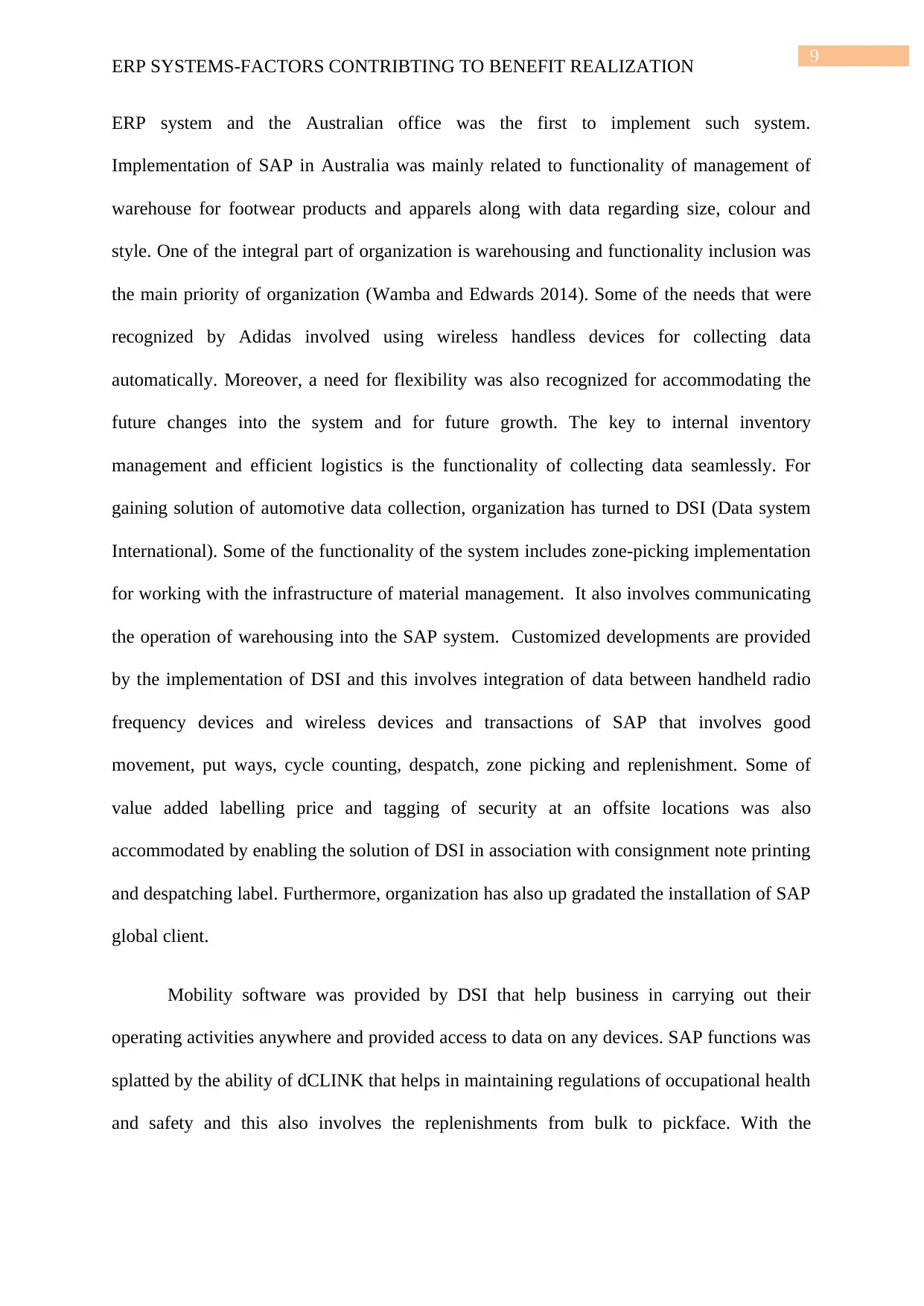
9
ERP SYSTEMS-FACTORS CONTRIBTING TO BENEFIT REALIZATION
ERP system and the Australian office was the first to implement such system.
Implementation of SAP in Australia was mainly related to functionality of management of
warehouse for footwear products and apparels along with data regarding size, colour and
style. One of the integral part of organization is warehousing and functionality inclusion was
the main priority of organization (Wamba and Edwards 2014). Some of the needs that were
recognized by Adidas involved using wireless handless devices for collecting data
automatically. Moreover, a need for flexibility was also recognized for accommodating the
future changes into the system and for future growth. The key to internal inventory
management and efficient logistics is the functionality of collecting data seamlessly. For
gaining solution of automotive data collection, organization has turned to DSI (Data system
International). Some of the functionality of the system includes zone-picking implementation
for working with the infrastructure of material management. It also involves communicating
the operation of warehousing into the SAP system. Customized developments are provided
by the implementation of DSI and this involves integration of data between handheld radio
frequency devices and wireless devices and transactions of SAP that involves good
movement, put ways, cycle counting, despatch, zone picking and replenishment. Some of
value added labelling price and tagging of security at an offsite locations was also
accommodated by enabling the solution of DSI in association with consignment note printing
and despatching label. Furthermore, organization has also up gradated the installation of SAP
global client.
Mobility software was provided by DSI that help business in carrying out their
operating activities anywhere and provided access to data on any devices. SAP functions was
splatted by the ability of dCLINK that helps in maintaining regulations of occupational health
and safety and this also involves the replenishments from bulk to pickface. With the
ERP SYSTEMS-FACTORS CONTRIBTING TO BENEFIT REALIZATION
ERP system and the Australian office was the first to implement such system.
Implementation of SAP in Australia was mainly related to functionality of management of
warehouse for footwear products and apparels along with data regarding size, colour and
style. One of the integral part of organization is warehousing and functionality inclusion was
the main priority of organization (Wamba and Edwards 2014). Some of the needs that were
recognized by Adidas involved using wireless handless devices for collecting data
automatically. Moreover, a need for flexibility was also recognized for accommodating the
future changes into the system and for future growth. The key to internal inventory
management and efficient logistics is the functionality of collecting data seamlessly. For
gaining solution of automotive data collection, organization has turned to DSI (Data system
International). Some of the functionality of the system includes zone-picking implementation
for working with the infrastructure of material management. It also involves communicating
the operation of warehousing into the SAP system. Customized developments are provided
by the implementation of DSI and this involves integration of data between handheld radio
frequency devices and wireless devices and transactions of SAP that involves good
movement, put ways, cycle counting, despatch, zone picking and replenishment. Some of
value added labelling price and tagging of security at an offsite locations was also
accommodated by enabling the solution of DSI in association with consignment note printing
and despatching label. Furthermore, organization has also up gradated the installation of SAP
global client.
Mobility software was provided by DSI that help business in carrying out their
operating activities anywhere and provided access to data on any devices. SAP functions was
splatted by the ability of dCLINK that helps in maintaining regulations of occupational health
and safety and this also involves the replenishments from bulk to pickface. With the
Secure Best Marks with AI Grader
Need help grading? Try our AI Grader for instant feedback on your assignments.
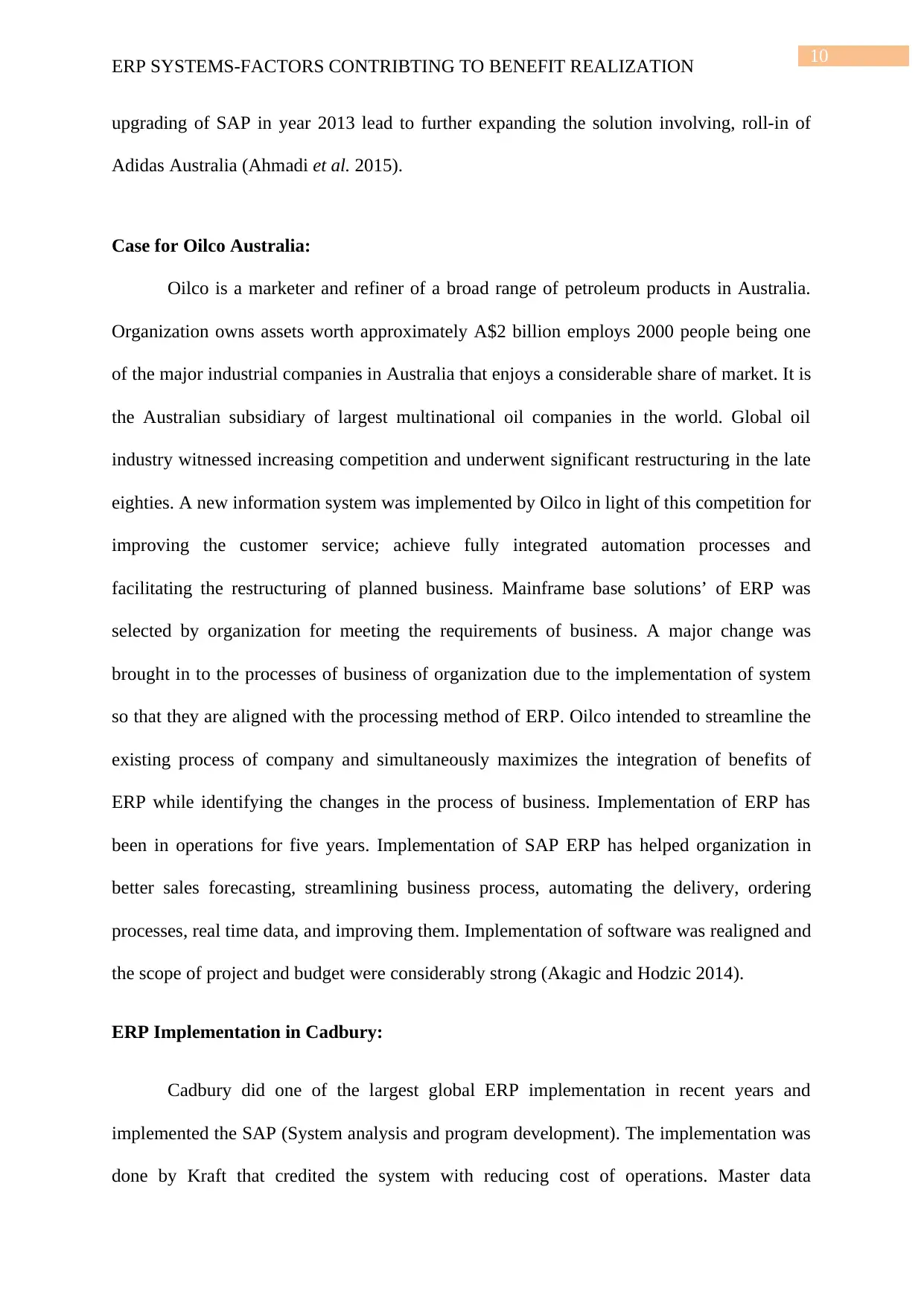
10
ERP SYSTEMS-FACTORS CONTRIBTING TO BENEFIT REALIZATION
upgrading of SAP in year 2013 lead to further expanding the solution involving, roll-in of
Adidas Australia (Ahmadi et al. 2015).
Case for Oilco Australia:
Oilco is a marketer and refiner of a broad range of petroleum products in Australia.
Organization owns assets worth approximately A$2 billion employs 2000 people being one
of the major industrial companies in Australia that enjoys a considerable share of market. It is
the Australian subsidiary of largest multinational oil companies in the world. Global oil
industry witnessed increasing competition and underwent significant restructuring in the late
eighties. A new information system was implemented by Oilco in light of this competition for
improving the customer service; achieve fully integrated automation processes and
facilitating the restructuring of planned business. Mainframe base solutions’ of ERP was
selected by organization for meeting the requirements of business. A major change was
brought in to the processes of business of organization due to the implementation of system
so that they are aligned with the processing method of ERP. Oilco intended to streamline the
existing process of company and simultaneously maximizes the integration of benefits of
ERP while identifying the changes in the process of business. Implementation of ERP has
been in operations for five years. Implementation of SAP ERP has helped organization in
better sales forecasting, streamlining business process, automating the delivery, ordering
processes, real time data, and improving them. Implementation of software was realigned and
the scope of project and budget were considerably strong (Akagic and Hodzic 2014).
ERP Implementation in Cadbury:
Cadbury did one of the largest global ERP implementation in recent years and
implemented the SAP (System analysis and program development). The implementation was
done by Kraft that credited the system with reducing cost of operations. Master data
ERP SYSTEMS-FACTORS CONTRIBTING TO BENEFIT REALIZATION
upgrading of SAP in year 2013 lead to further expanding the solution involving, roll-in of
Adidas Australia (Ahmadi et al. 2015).
Case for Oilco Australia:
Oilco is a marketer and refiner of a broad range of petroleum products in Australia.
Organization owns assets worth approximately A$2 billion employs 2000 people being one
of the major industrial companies in Australia that enjoys a considerable share of market. It is
the Australian subsidiary of largest multinational oil companies in the world. Global oil
industry witnessed increasing competition and underwent significant restructuring in the late
eighties. A new information system was implemented by Oilco in light of this competition for
improving the customer service; achieve fully integrated automation processes and
facilitating the restructuring of planned business. Mainframe base solutions’ of ERP was
selected by organization for meeting the requirements of business. A major change was
brought in to the processes of business of organization due to the implementation of system
so that they are aligned with the processing method of ERP. Oilco intended to streamline the
existing process of company and simultaneously maximizes the integration of benefits of
ERP while identifying the changes in the process of business. Implementation of ERP has
been in operations for five years. Implementation of SAP ERP has helped organization in
better sales forecasting, streamlining business process, automating the delivery, ordering
processes, real time data, and improving them. Implementation of software was realigned and
the scope of project and budget were considerably strong (Akagic and Hodzic 2014).
ERP Implementation in Cadbury:
Cadbury did one of the largest global ERP implementation in recent years and
implemented the SAP (System analysis and program development). The implementation was
done by Kraft that credited the system with reducing cost of operations. Master data
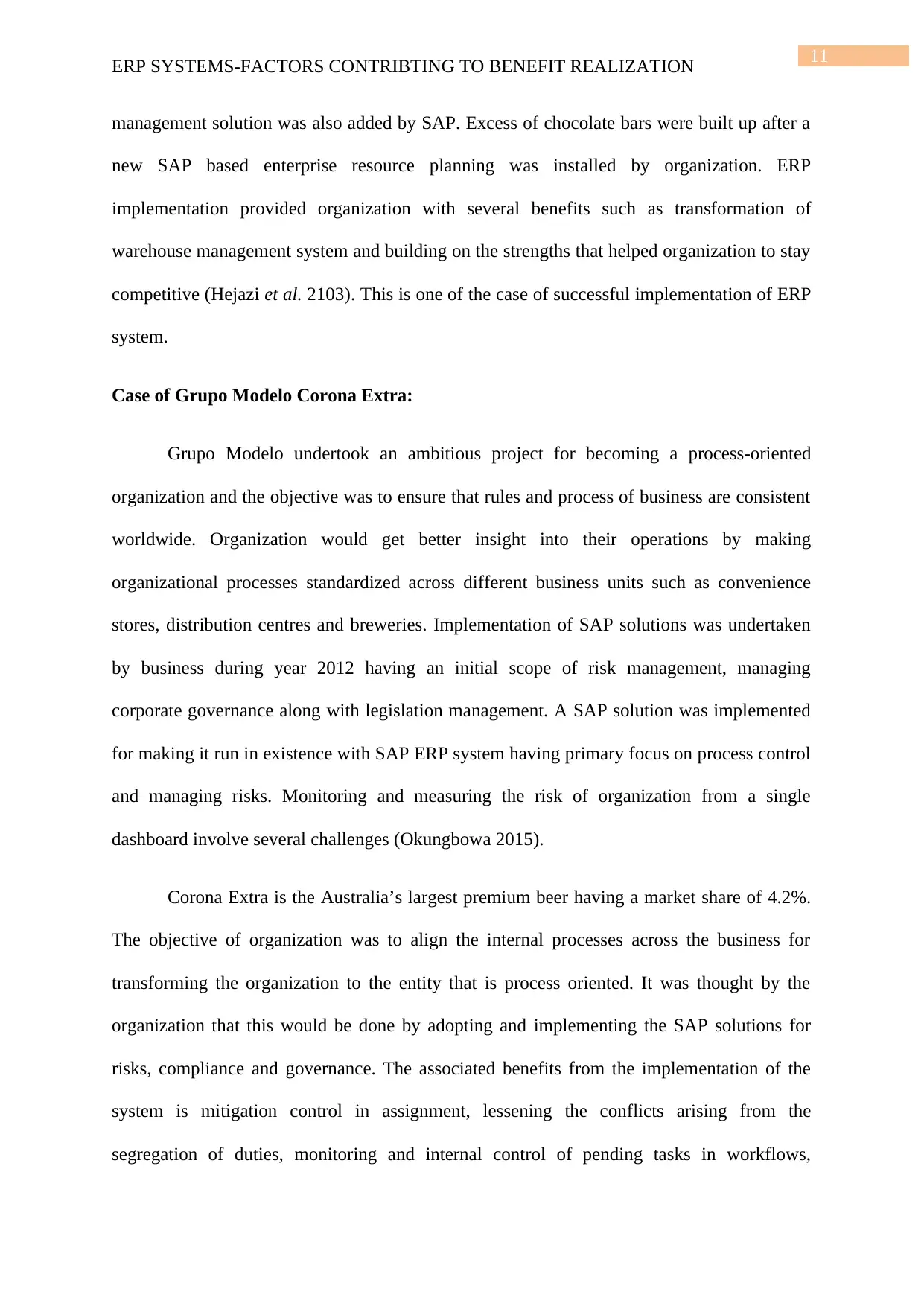
11
ERP SYSTEMS-FACTORS CONTRIBTING TO BENEFIT REALIZATION
management solution was also added by SAP. Excess of chocolate bars were built up after a
new SAP based enterprise resource planning was installed by organization. ERP
implementation provided organization with several benefits such as transformation of
warehouse management system and building on the strengths that helped organization to stay
competitive (Hejazi et al. 2103). This is one of the case of successful implementation of ERP
system.
Case of Grupo Modelo Corona Extra:
Grupo Modelo undertook an ambitious project for becoming a process-oriented
organization and the objective was to ensure that rules and process of business are consistent
worldwide. Organization would get better insight into their operations by making
organizational processes standardized across different business units such as convenience
stores, distribution centres and breweries. Implementation of SAP solutions was undertaken
by business during year 2012 having an initial scope of risk management, managing
corporate governance along with legislation management. A SAP solution was implemented
for making it run in existence with SAP ERP system having primary focus on process control
and managing risks. Monitoring and measuring the risk of organization from a single
dashboard involve several challenges (Okungbowa 2015).
Corona Extra is the Australia’s largest premium beer having a market share of 4.2%.
The objective of organization was to align the internal processes across the business for
transforming the organization to the entity that is process oriented. It was thought by the
organization that this would be done by adopting and implementing the SAP solutions for
risks, compliance and governance. The associated benefits from the implementation of the
system is mitigation control in assignment, lessening the conflicts arising from the
segregation of duties, monitoring and internal control of pending tasks in workflows,
ERP SYSTEMS-FACTORS CONTRIBTING TO BENEFIT REALIZATION
management solution was also added by SAP. Excess of chocolate bars were built up after a
new SAP based enterprise resource planning was installed by organization. ERP
implementation provided organization with several benefits such as transformation of
warehouse management system and building on the strengths that helped organization to stay
competitive (Hejazi et al. 2103). This is one of the case of successful implementation of ERP
system.
Case of Grupo Modelo Corona Extra:
Grupo Modelo undertook an ambitious project for becoming a process-oriented
organization and the objective was to ensure that rules and process of business are consistent
worldwide. Organization would get better insight into their operations by making
organizational processes standardized across different business units such as convenience
stores, distribution centres and breweries. Implementation of SAP solutions was undertaken
by business during year 2012 having an initial scope of risk management, managing
corporate governance along with legislation management. A SAP solution was implemented
for making it run in existence with SAP ERP system having primary focus on process control
and managing risks. Monitoring and measuring the risk of organization from a single
dashboard involve several challenges (Okungbowa 2015).
Corona Extra is the Australia’s largest premium beer having a market share of 4.2%.
The objective of organization was to align the internal processes across the business for
transforming the organization to the entity that is process oriented. It was thought by the
organization that this would be done by adopting and implementing the SAP solutions for
risks, compliance and governance. The associated benefits from the implementation of the
system is mitigation control in assignment, lessening the conflicts arising from the
segregation of duties, monitoring and internal control of pending tasks in workflows,
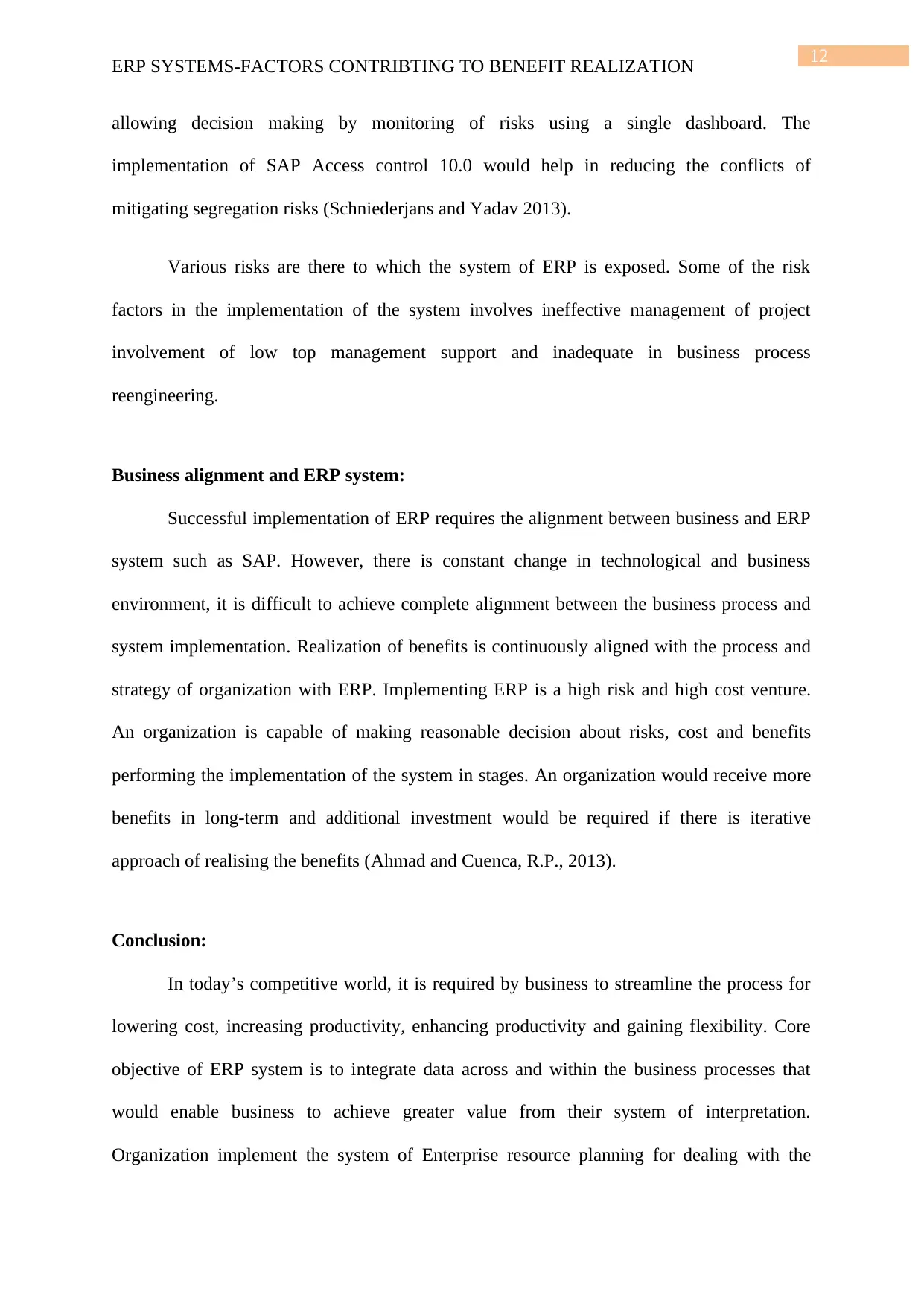
12
ERP SYSTEMS-FACTORS CONTRIBTING TO BENEFIT REALIZATION
allowing decision making by monitoring of risks using a single dashboard. The
implementation of SAP Access control 10.0 would help in reducing the conflicts of
mitigating segregation risks (Schniederjans and Yadav 2013).
Various risks are there to which the system of ERP is exposed. Some of the risk
factors in the implementation of the system involves ineffective management of project
involvement of low top management support and inadequate in business process
reengineering.
Business alignment and ERP system:
Successful implementation of ERP requires the alignment between business and ERP
system such as SAP. However, there is constant change in technological and business
environment, it is difficult to achieve complete alignment between the business process and
system implementation. Realization of benefits is continuously aligned with the process and
strategy of organization with ERP. Implementing ERP is a high risk and high cost venture.
An organization is capable of making reasonable decision about risks, cost and benefits
performing the implementation of the system in stages. An organization would receive more
benefits in long-term and additional investment would be required if there is iterative
approach of realising the benefits (Ahmad and Cuenca, R.P., 2013).
Conclusion:
In today’s competitive world, it is required by business to streamline the process for
lowering cost, increasing productivity, enhancing productivity and gaining flexibility. Core
objective of ERP system is to integrate data across and within the business processes that
would enable business to achieve greater value from their system of interpretation.
Organization implement the system of Enterprise resource planning for dealing with the
ERP SYSTEMS-FACTORS CONTRIBTING TO BENEFIT REALIZATION
allowing decision making by monitoring of risks using a single dashboard. The
implementation of SAP Access control 10.0 would help in reducing the conflicts of
mitigating segregation risks (Schniederjans and Yadav 2013).
Various risks are there to which the system of ERP is exposed. Some of the risk
factors in the implementation of the system involves ineffective management of project
involvement of low top management support and inadequate in business process
reengineering.
Business alignment and ERP system:
Successful implementation of ERP requires the alignment between business and ERP
system such as SAP. However, there is constant change in technological and business
environment, it is difficult to achieve complete alignment between the business process and
system implementation. Realization of benefits is continuously aligned with the process and
strategy of organization with ERP. Implementing ERP is a high risk and high cost venture.
An organization is capable of making reasonable decision about risks, cost and benefits
performing the implementation of the system in stages. An organization would receive more
benefits in long-term and additional investment would be required if there is iterative
approach of realising the benefits (Ahmad and Cuenca, R.P., 2013).
Conclusion:
In today’s competitive world, it is required by business to streamline the process for
lowering cost, increasing productivity, enhancing productivity and gaining flexibility. Core
objective of ERP system is to integrate data across and within the business processes that
would enable business to achieve greater value from their system of interpretation.
Organization implement the system of Enterprise resource planning for dealing with the
Paraphrase This Document
Need a fresh take? Get an instant paraphrase of this document with our AI Paraphraser
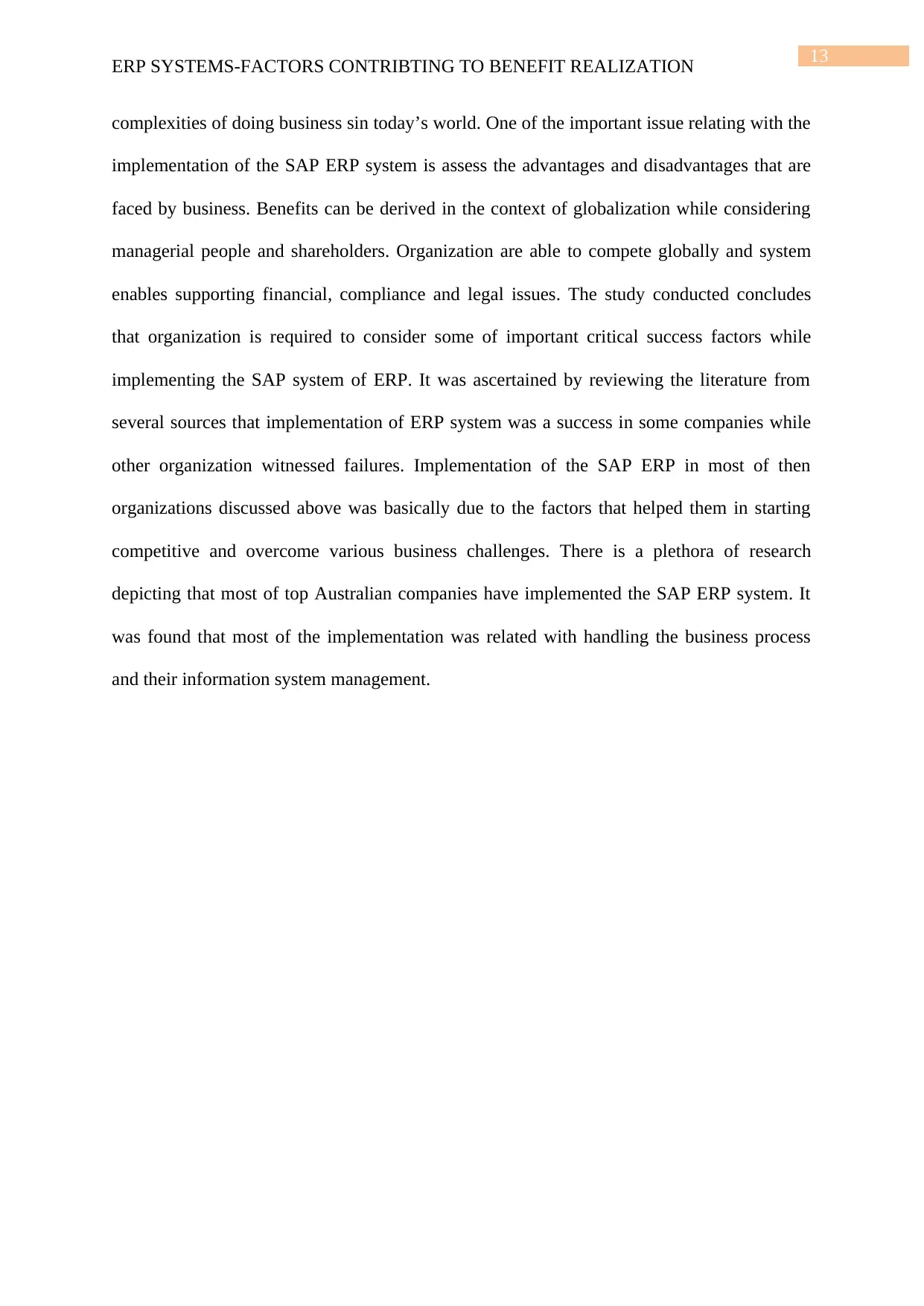
13
ERP SYSTEMS-FACTORS CONTRIBTING TO BENEFIT REALIZATION
complexities of doing business sin today’s world. One of the important issue relating with the
implementation of the SAP ERP system is assess the advantages and disadvantages that are
faced by business. Benefits can be derived in the context of globalization while considering
managerial people and shareholders. Organization are able to compete globally and system
enables supporting financial, compliance and legal issues. The study conducted concludes
that organization is required to consider some of important critical success factors while
implementing the SAP system of ERP. It was ascertained by reviewing the literature from
several sources that implementation of ERP system was a success in some companies while
other organization witnessed failures. Implementation of the SAP ERP in most of then
organizations discussed above was basically due to the factors that helped them in starting
competitive and overcome various business challenges. There is a plethora of research
depicting that most of top Australian companies have implemented the SAP ERP system. It
was found that most of the implementation was related with handling the business process
and their information system management.
ERP SYSTEMS-FACTORS CONTRIBTING TO BENEFIT REALIZATION
complexities of doing business sin today’s world. One of the important issue relating with the
implementation of the SAP ERP system is assess the advantages and disadvantages that are
faced by business. Benefits can be derived in the context of globalization while considering
managerial people and shareholders. Organization are able to compete globally and system
enables supporting financial, compliance and legal issues. The study conducted concludes
that organization is required to consider some of important critical success factors while
implementing the SAP system of ERP. It was ascertained by reviewing the literature from
several sources that implementation of ERP system was a success in some companies while
other organization witnessed failures. Implementation of the SAP ERP in most of then
organizations discussed above was basically due to the factors that helped them in starting
competitive and overcome various business challenges. There is a plethora of research
depicting that most of top Australian companies have implemented the SAP ERP system. It
was found that most of the implementation was related with handling the business process
and their information system management.
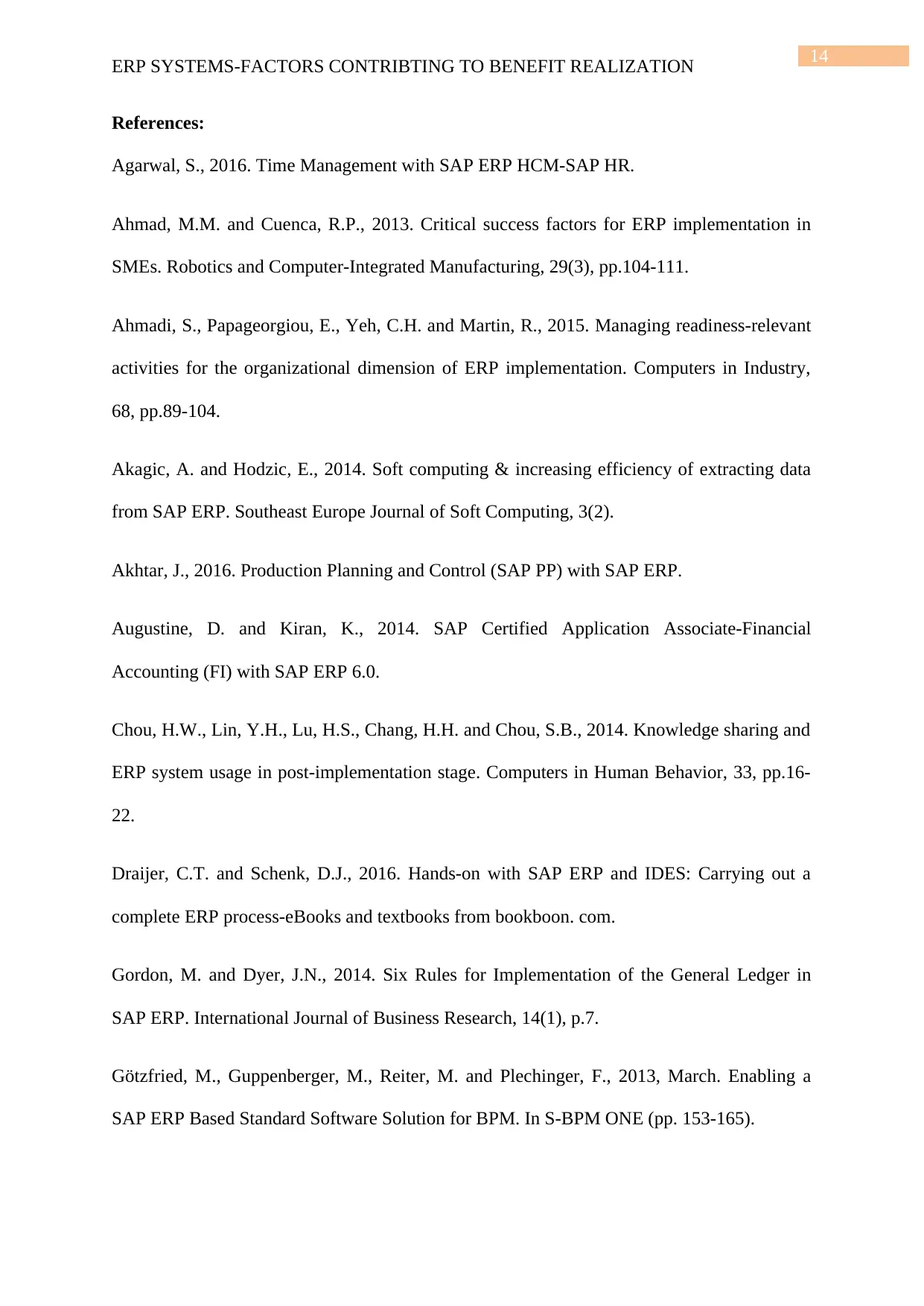
14
ERP SYSTEMS-FACTORS CONTRIBTING TO BENEFIT REALIZATION
References:
Agarwal, S., 2016. Time Management with SAP ERP HCM-SAP HR.
Ahmad, M.M. and Cuenca, R.P., 2013. Critical success factors for ERP implementation in
SMEs. Robotics and Computer-Integrated Manufacturing, 29(3), pp.104-111.
Ahmadi, S., Papageorgiou, E., Yeh, C.H. and Martin, R., 2015. Managing readiness-relevant
activities for the organizational dimension of ERP implementation. Computers in Industry,
68, pp.89-104.
Akagic, A. and Hodzic, E., 2014. Soft computing & increasing efficiency of extracting data
from SAP ERP. Southeast Europe Journal of Soft Computing, 3(2).
Akhtar, J., 2016. Production Planning and Control (SAP PP) with SAP ERP.
Augustine, D. and Kiran, K., 2014. SAP Certified Application Associate-Financial
Accounting (FI) with SAP ERP 6.0.
Chou, H.W., Lin, Y.H., Lu, H.S., Chang, H.H. and Chou, S.B., 2014. Knowledge sharing and
ERP system usage in post-implementation stage. Computers in Human Behavior, 33, pp.16-
22.
Draijer, C.T. and Schenk, D.J., 2016. Hands-on with SAP ERP and IDES: Carrying out a
complete ERP process-eBooks and textbooks from bookboon. com.
Gordon, M. and Dyer, J.N., 2014. Six Rules for Implementation of the General Ledger in
SAP ERP. International Journal of Business Research, 14(1), p.7.
Götzfried, M., Guppenberger, M., Reiter, M. and Plechinger, F., 2013, March. Enabling a
SAP ERP Based Standard Software Solution for BPM. In S-BPM ONE (pp. 153-165).
ERP SYSTEMS-FACTORS CONTRIBTING TO BENEFIT REALIZATION
References:
Agarwal, S., 2016. Time Management with SAP ERP HCM-SAP HR.
Ahmad, M.M. and Cuenca, R.P., 2013. Critical success factors for ERP implementation in
SMEs. Robotics and Computer-Integrated Manufacturing, 29(3), pp.104-111.
Ahmadi, S., Papageorgiou, E., Yeh, C.H. and Martin, R., 2015. Managing readiness-relevant
activities for the organizational dimension of ERP implementation. Computers in Industry,
68, pp.89-104.
Akagic, A. and Hodzic, E., 2014. Soft computing & increasing efficiency of extracting data
from SAP ERP. Southeast Europe Journal of Soft Computing, 3(2).
Akhtar, J., 2016. Production Planning and Control (SAP PP) with SAP ERP.
Augustine, D. and Kiran, K., 2014. SAP Certified Application Associate-Financial
Accounting (FI) with SAP ERP 6.0.
Chou, H.W., Lin, Y.H., Lu, H.S., Chang, H.H. and Chou, S.B., 2014. Knowledge sharing and
ERP system usage in post-implementation stage. Computers in Human Behavior, 33, pp.16-
22.
Draijer, C.T. and Schenk, D.J., 2016. Hands-on with SAP ERP and IDES: Carrying out a
complete ERP process-eBooks and textbooks from bookboon. com.
Gordon, M. and Dyer, J.N., 2014. Six Rules for Implementation of the General Ledger in
SAP ERP. International Journal of Business Research, 14(1), p.7.
Götzfried, M., Guppenberger, M., Reiter, M. and Plechinger, F., 2013, March. Enabling a
SAP ERP Based Standard Software Solution for BPM. In S-BPM ONE (pp. 153-165).
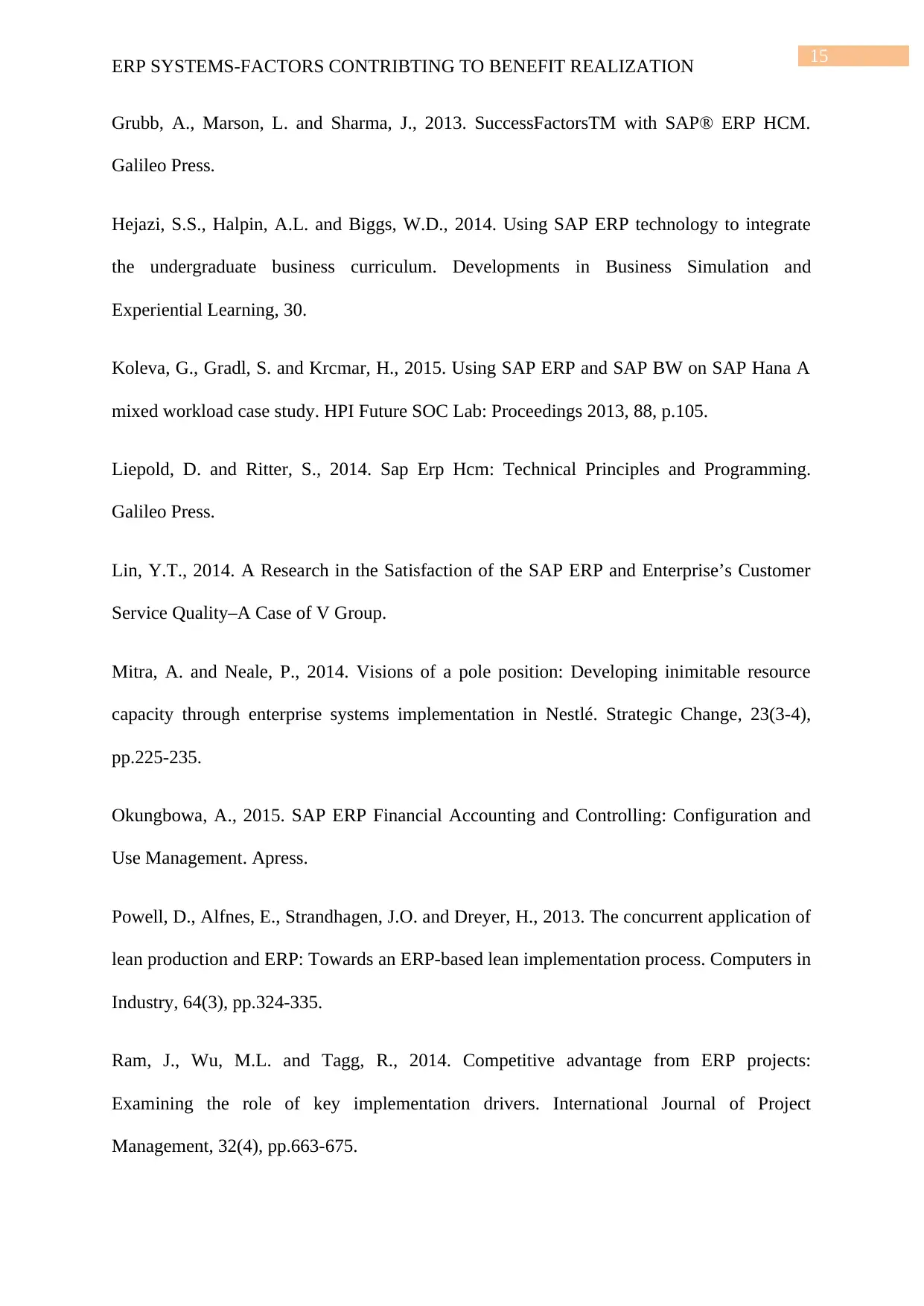
15
ERP SYSTEMS-FACTORS CONTRIBTING TO BENEFIT REALIZATION
Grubb, A., Marson, L. and Sharma, J., 2013. SuccessFactorsTM with SAP® ERP HCM.
Galileo Press.
Hejazi, S.S., Halpin, A.L. and Biggs, W.D., 2014. Using SAP ERP technology to integrate
the undergraduate business curriculum. Developments in Business Simulation and
Experiential Learning, 30.
Koleva, G., Gradl, S. and Krcmar, H., 2015. Using SAP ERP and SAP BW on SAP Hana A
mixed workload case study. HPI Future SOC Lab: Proceedings 2013, 88, p.105.
Liepold, D. and Ritter, S., 2014. Sap Erp Hcm: Technical Principles and Programming.
Galileo Press.
Lin, Y.T., 2014. A Research in the Satisfaction of the SAP ERP and Enterprise’s Customer
Service Quality–A Case of V Group.
Mitra, A. and Neale, P., 2014. Visions of a pole position: Developing inimitable resource
capacity through enterprise systems implementation in Nestlé. Strategic Change, 23(3-4),
pp.225-235.
Okungbowa, A., 2015. SAP ERP Financial Accounting and Controlling: Configuration and
Use Management. Apress.
Powell, D., Alfnes, E., Strandhagen, J.O. and Dreyer, H., 2013. The concurrent application of
lean production and ERP: Towards an ERP-based lean implementation process. Computers in
Industry, 64(3), pp.324-335.
Ram, J., Wu, M.L. and Tagg, R., 2014. Competitive advantage from ERP projects:
Examining the role of key implementation drivers. International Journal of Project
Management, 32(4), pp.663-675.
ERP SYSTEMS-FACTORS CONTRIBTING TO BENEFIT REALIZATION
Grubb, A., Marson, L. and Sharma, J., 2013. SuccessFactorsTM with SAP® ERP HCM.
Galileo Press.
Hejazi, S.S., Halpin, A.L. and Biggs, W.D., 2014. Using SAP ERP technology to integrate
the undergraduate business curriculum. Developments in Business Simulation and
Experiential Learning, 30.
Koleva, G., Gradl, S. and Krcmar, H., 2015. Using SAP ERP and SAP BW on SAP Hana A
mixed workload case study. HPI Future SOC Lab: Proceedings 2013, 88, p.105.
Liepold, D. and Ritter, S., 2014. Sap Erp Hcm: Technical Principles and Programming.
Galileo Press.
Lin, Y.T., 2014. A Research in the Satisfaction of the SAP ERP and Enterprise’s Customer
Service Quality–A Case of V Group.
Mitra, A. and Neale, P., 2014. Visions of a pole position: Developing inimitable resource
capacity through enterprise systems implementation in Nestlé. Strategic Change, 23(3-4),
pp.225-235.
Okungbowa, A., 2015. SAP ERP Financial Accounting and Controlling: Configuration and
Use Management. Apress.
Powell, D., Alfnes, E., Strandhagen, J.O. and Dreyer, H., 2013. The concurrent application of
lean production and ERP: Towards an ERP-based lean implementation process. Computers in
Industry, 64(3), pp.324-335.
Ram, J., Wu, M.L. and Tagg, R., 2014. Competitive advantage from ERP projects:
Examining the role of key implementation drivers. International Journal of Project
Management, 32(4), pp.663-675.
Secure Best Marks with AI Grader
Need help grading? Try our AI Grader for instant feedback on your assignments.
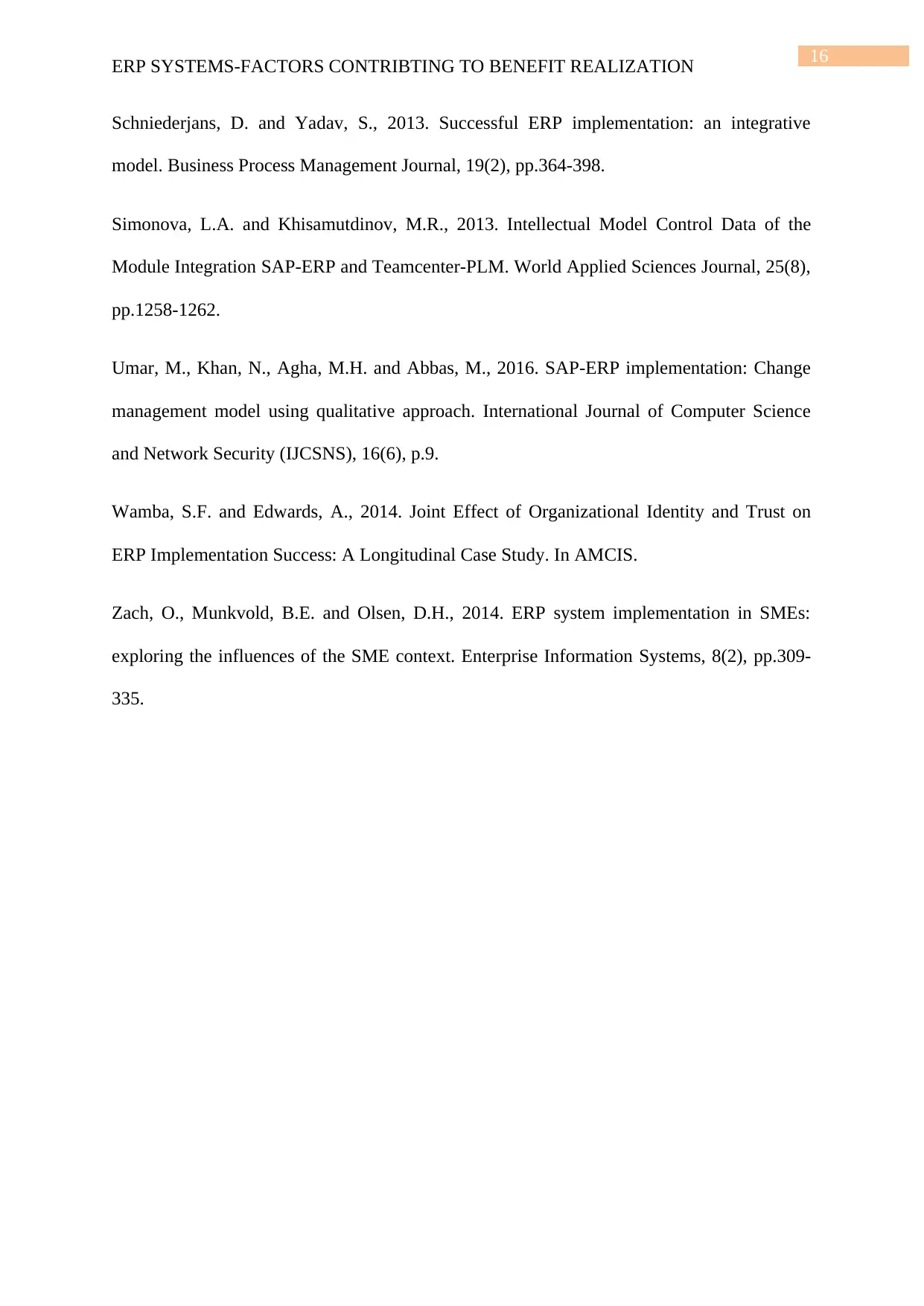
16
ERP SYSTEMS-FACTORS CONTRIBTING TO BENEFIT REALIZATION
Schniederjans, D. and Yadav, S., 2013. Successful ERP implementation: an integrative
model. Business Process Management Journal, 19(2), pp.364-398.
Simonova, L.A. and Khisamutdinov, M.R., 2013. Intellectual Model Control Data of the
Module Integration SAP-ERP and Teamcenter-PLM. World Applied Sciences Journal, 25(8),
pp.1258-1262.
Umar, M., Khan, N., Agha, M.H. and Abbas, M., 2016. SAP-ERP implementation: Change
management model using qualitative approach. International Journal of Computer Science
and Network Security (IJCSNS), 16(6), p.9.
Wamba, S.F. and Edwards, A., 2014. Joint Effect of Organizational Identity and Trust on
ERP Implementation Success: A Longitudinal Case Study. In AMCIS.
Zach, O., Munkvold, B.E. and Olsen, D.H., 2014. ERP system implementation in SMEs:
exploring the influences of the SME context. Enterprise Information Systems, 8(2), pp.309-
335.
ERP SYSTEMS-FACTORS CONTRIBTING TO BENEFIT REALIZATION
Schniederjans, D. and Yadav, S., 2013. Successful ERP implementation: an integrative
model. Business Process Management Journal, 19(2), pp.364-398.
Simonova, L.A. and Khisamutdinov, M.R., 2013. Intellectual Model Control Data of the
Module Integration SAP-ERP and Teamcenter-PLM. World Applied Sciences Journal, 25(8),
pp.1258-1262.
Umar, M., Khan, N., Agha, M.H. and Abbas, M., 2016. SAP-ERP implementation: Change
management model using qualitative approach. International Journal of Computer Science
and Network Security (IJCSNS), 16(6), p.9.
Wamba, S.F. and Edwards, A., 2014. Joint Effect of Organizational Identity and Trust on
ERP Implementation Success: A Longitudinal Case Study. In AMCIS.
Zach, O., Munkvold, B.E. and Olsen, D.H., 2014. ERP system implementation in SMEs:
exploring the influences of the SME context. Enterprise Information Systems, 8(2), pp.309-
335.
1 out of 17
Related Documents
Your All-in-One AI-Powered Toolkit for Academic Success.
+13062052269
info@desklib.com
Available 24*7 on WhatsApp / Email
![[object Object]](/_next/static/media/star-bottom.7253800d.svg)
Unlock your academic potential
© 2024 | Zucol Services PVT LTD | All rights reserved.





